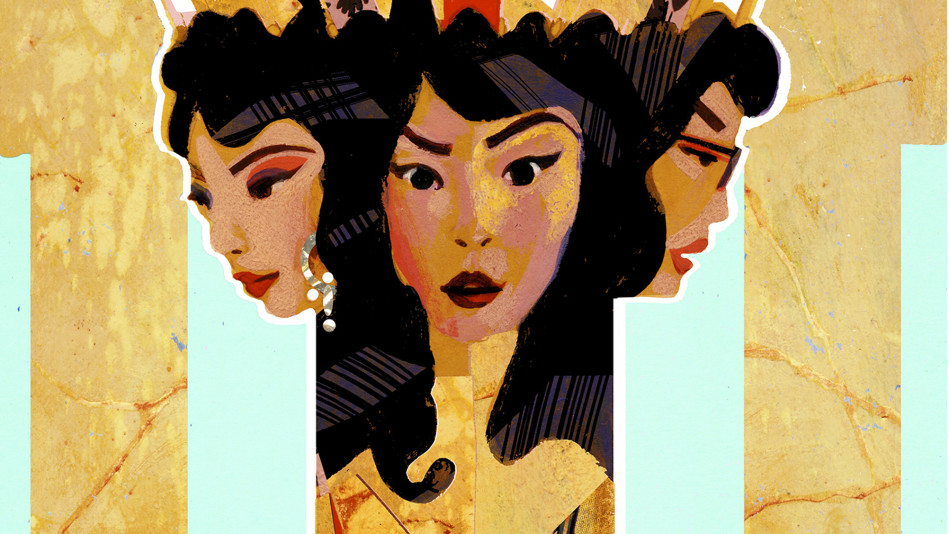What a Toxic Friend Taught Elizabeth Gilbert About Herself
How to be the real you? Teach your various sides to live harmoniously.

Illustrations: Julia Breckenreid
A few months ago, I found myself in a toxic situation with an old friend. For some mysterious reason, he had suddenly turned against me and would make snide comments to me every time we encountered each other.
I had no idea what to do. My response to his hostility was to disintegrate into total emotional confusion, which always happens to me during interpersonal conflicts. I became splintered and overwhelmed. Part of me felt victimized and self-pitying, part of me felt like I was being oversensitive and should just shake it off, and part of me was so fierce with righteous indignation that I dreamed of taking the bastard's head off. I simultaneously wanted to run away from my friend, totally forgive him, and mercilessly destroy him in a savage counterattack. At first I wondered who all these rival voices in my head were, sending me such contradictory messages about how to feel and behave. And which voice represented my true self? Thankfully, I was familiar with a concept that helped me understand why I was having so many different reactions at once. I had discovered the work of a therapist named Richard Schwartz, PhD, who suggests that perhaps none of us is really a single unified self, but instead a compilation of many various selves. He calls these rival selves our "parts" and claims that they often work at cross-purposes.
We all understand this, instinctually. It's what you're referring to, after all, when you say things like "Part of me is excited, but another part of me is terrified," or "Part of me wants to quit my job, but another part of me craves the security of a regular paycheck."
Schwartz reassures us that containing all these different parts doesn't make us crazy; it merely makes us human. He also suggests that if we can identify and name the distinct parts of ourselves, we might have an easier time managing our lives.
Inspired by this idea, I did some deep diving to try to identify the most prominent selves dwelling within me. After careful investigation, I was able to find and name three.
So here I am. Rather, here we are:
1. Meet Lizzy. Lizzy is an anxious little kid who lives in terror of conflict and abandonment. Lizzy annoys me because she's so helpless, but she also has great strengths. She feels compassion toward everyone because she knows how hard life is. Lizzy may be fearful, but she is also kind. Without her, I would have no heart.
2. Meet Elizabeth. Elizabeth is my inner creator. She's a grand and passionate risk taker. I love Elizabeth because she's so artistic (she's the reason I'm a writer). But she also has a dark side: She can be reckless, and she stubbornly refuses to accept reality.
3. Meet Ms. Gilbert. Ms. Gilbert is my most "grown-up" self. She's the emotional opposite of both Lizzy and Elizabeth. She's responsible, brave, organized, and independent. But she can also be a harsh and unforgiving critic of herself and others, and her only solution to any problem is "Everyone must do better!"

When I asked these three selves how they felt about my conflict with my friend, each had a different answer. And I began to understand how this situation had triggered the worst qualities of each of my parts: Tiny Lizzy felt afraid and powerless, while Elizabeth the Utopian blindly denied there was a problem at all, and judgmental Ms. Gilbert was ready to banish this horrible person from her life forever. It was only when I invited all three of my selves to bring their best aspects to the table (Lizzy's empathy, Elizabeth's creativity, Ms. Gilbert's strength) that I was finally able to talk calmly to my friend about our problems, and we resolved the dispute in a loving manner.
The ancient Greeks believed that the height of human wisdom was to "know thyself," but I think they had it wrong. The real trick is to know thyselves—because if you can find a way for all your parts to peacefully coexist, you might actually have a chance to live in harmony.
And that, in the end, is what all of us want.
Elizabeth Gilbert is the author of, most recently, Big Magic: Creative Living Beyond Fear.
I had no idea what to do. My response to his hostility was to disintegrate into total emotional confusion, which always happens to me during interpersonal conflicts. I became splintered and overwhelmed. Part of me felt victimized and self-pitying, part of me felt like I was being oversensitive and should just shake it off, and part of me was so fierce with righteous indignation that I dreamed of taking the bastard's head off. I simultaneously wanted to run away from my friend, totally forgive him, and mercilessly destroy him in a savage counterattack. At first I wondered who all these rival voices in my head were, sending me such contradictory messages about how to feel and behave. And which voice represented my true self? Thankfully, I was familiar with a concept that helped me understand why I was having so many different reactions at once. I had discovered the work of a therapist named Richard Schwartz, PhD, who suggests that perhaps none of us is really a single unified self, but instead a compilation of many various selves. He calls these rival selves our "parts" and claims that they often work at cross-purposes.
We all understand this, instinctually. It's what you're referring to, after all, when you say things like "Part of me is excited, but another part of me is terrified," or "Part of me wants to quit my job, but another part of me craves the security of a regular paycheck."
Schwartz reassures us that containing all these different parts doesn't make us crazy; it merely makes us human. He also suggests that if we can identify and name the distinct parts of ourselves, we might have an easier time managing our lives.
Inspired by this idea, I did some deep diving to try to identify the most prominent selves dwelling within me. After careful investigation, I was able to find and name three.
So here I am. Rather, here we are:
1. Meet Lizzy. Lizzy is an anxious little kid who lives in terror of conflict and abandonment. Lizzy annoys me because she's so helpless, but she also has great strengths. She feels compassion toward everyone because she knows how hard life is. Lizzy may be fearful, but she is also kind. Without her, I would have no heart.
2. Meet Elizabeth. Elizabeth is my inner creator. She's a grand and passionate risk taker. I love Elizabeth because she's so artistic (she's the reason I'm a writer). But she also has a dark side: She can be reckless, and she stubbornly refuses to accept reality.
3. Meet Ms. Gilbert. Ms. Gilbert is my most "grown-up" self. She's the emotional opposite of both Lizzy and Elizabeth. She's responsible, brave, organized, and independent. But she can also be a harsh and unforgiving critic of herself and others, and her only solution to any problem is "Everyone must do better!"

When I asked these three selves how they felt about my conflict with my friend, each had a different answer. And I began to understand how this situation had triggered the worst qualities of each of my parts: Tiny Lizzy felt afraid and powerless, while Elizabeth the Utopian blindly denied there was a problem at all, and judgmental Ms. Gilbert was ready to banish this horrible person from her life forever. It was only when I invited all three of my selves to bring their best aspects to the table (Lizzy's empathy, Elizabeth's creativity, Ms. Gilbert's strength) that I was finally able to talk calmly to my friend about our problems, and we resolved the dispute in a loving manner.
The ancient Greeks believed that the height of human wisdom was to "know thyself," but I think they had it wrong. The real trick is to know thyselves—because if you can find a way for all your parts to peacefully coexist, you might actually have a chance to live in harmony.
And that, in the end, is what all of us want.
Elizabeth Gilbert is the author of, most recently, Big Magic: Creative Living Beyond Fear.



